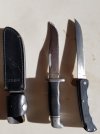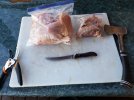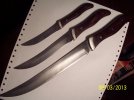jbm, even on this edge working I did not reprofile. I think the bevel is set at a angle I like and tend to hit
with the angle I normally hold. Thinking back one of the flat spots could have been created when I cut thru
a foot and hit the head of a wood screw. That one I noticed when I grabbed the foot to toss it in the throw away bucket. I work at a good pace,- not much chatter. We both know what to do (as we've done this over 100 times)and Leesa is trying to keep the zip-loc bags flowing to stay with me. Which cut goes in what bag, as we have 2-3 bags rotating.
One for the meat cuts, breast, thighs, drums and wings. Another for soup, backs & necks and another for
heart, liver and gizzards. Each piece is washed after cutting and that bag called for or she's usually following my routine. Their health status is checked as we go; color of liver, fluid build up in the heart sack, reproductive organs are a health indicator, ect.. Both of us are giving this some attention. DM



